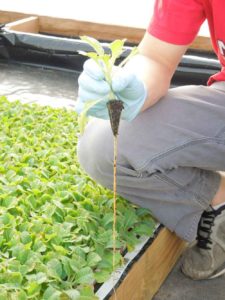A Greene Niche
- Leaf Print Edition
- November 1, 2021
- 0
- 1
- 12 minutes read


Despite its considerable profit margin, U.S. organic tobacco is likely to remain a marginal crop.
By Stefanie Rossel
Across all areas of life, sustainability has become an ever more important issue for consumers. Global sales of organic food, for example, have increased between nearly $18 billion in 2000 to $106 billion in 2019, according to Statista. Cigarettes made of organically grown tobacco, however, continue to remain a rarity. Many smokers are likely to be aware now that the combustion of tobacco leaves, a process that releases more than 7,000 chemical substances—among them more than 70 linked to cancer—makes cigarette consumption a hazardous habit regardless of whether the leaves have been cultivated in a certified organic way or conventionally. Thus, the unique selling proposition of organic cigarettes is not their comparative health risk but their lower impact on the environment.
Only a handful of tobacco companies offer organic smoking products, with Santa Fe Natural Tobacco Company being the most prominent player. According to Nielsen, the manufacturer’s American Spirit brand had a share of around 2 percent of the U.S. market in August 2021.

“Sustainability is the buzz with most companies today, including tobacco companies, but, at this point, I just don’t see organic tobacco capturing much of the market,” says William Snell, professor of agricultural economics at the University of Kentucky. “Keep in mind, even with the massive escalation of organics in our food markets, they still only comprise around 6 percent of today’s [U.S.] food market.”
That organic tobacco will likely remain a niche is also reflected by the amount of U.S. farmland dedicated to that crop.
“Demand for organic tobacco seems to have peaked, if we are basing it off of current acreage in the U.S. Data are limited, but we know that the bulk of organic flue-cured tobacco is produced in North Carolina, and our state’s organic-certified tobacco acreage has not increased since around 2017,” says David Suchoff, alternative crops Extension specialist and assistant professor at North Carolina State University. “Compared to conventional tobacco, certified organic tobacco still represents a very small percentage of the total crop produced. However, the general increase in North Carolina’s certified organic acreage can be attributed to tobacco as it tends to result in higher profit margins than many other organic field crops, making the transition from conventional to organic easier on the farmer.”

Decreasing Production
 According to the U.S. Department of Agriculture (USDA) National Agriculture Statistics Services, 181 farms cultivated 13.08 million pounds of organic tobacco in 2019, representing a value of $39.13 million. This compares to 467.96 million pounds of conventional leaf. With 18.62 million pounds, organic tobacco production was higher in 2018 but so was the conventional leaf crop, which stood at 628.72 million pounds in 2016. Of the 2019 U.S. organic tobacco crop, the majority was flue-cured Virginia. In 2019, 6.04 million pounds came from North Carolina and 2.28 million pounds from Virginia. Kentucky grew 1.14 million pounds of organic burley that year.
According to the U.S. Department of Agriculture (USDA) National Agriculture Statistics Services, 181 farms cultivated 13.08 million pounds of organic tobacco in 2019, representing a value of $39.13 million. This compares to 467.96 million pounds of conventional leaf. With 18.62 million pounds, organic tobacco production was higher in 2018 but so was the conventional leaf crop, which stood at 628.72 million pounds in 2016. Of the 2019 U.S. organic tobacco crop, the majority was flue-cured Virginia. In 2019, 6.04 million pounds came from North Carolina and 2.28 million pounds from Virginia. Kentucky grew 1.14 million pounds of organic burley that year.
In the first part of the last decade, Kentucky witnessed a rapid rise in interest in organic burley, followed by a steep drop, according to Robert C. Pearce, Extension professor at the College of Agriculture, Food and Environment at the University of Kentucky. “I assume [that happened] because they built an inventory of organic leaf that was not used as quickly as anticipated,” he says. “I only know of a handful of growers in Kentucky still cultivating organic burley. I don’t anticipate much increasing demand for organic burley. Burley tobacco is used in smokable products to absorb flavoring components. Since many natural/organic tobacco products do not utilize flavorings, burley is not needed in large amounts.”
In North Carolina, production of organic leaf has almost halved from 11.91 million pounds in 2016. The future of the segment is difficult to predict, says Matthew Vann, associate professor and Extension tobacco agronomist at North Carolina State University. “Obviously, we have the capacity to produce more organic leaf, but this is all dictated by the market. We do not foresee the organic leaf production to drop considerably, but we also do not expect demand to skyrocket. We do see opportunities for commercial farmers with serious interest in producing this style of tobacco, and we also want to make growers aware that organic production must be taken seriously due to the stringent regulations in place by the USDA National Organic Program and the standards outlined by leaf purchasers.”

Greater Efforts, Higher Profits

For farmers, the higher profits associated with organic tobacco tend to be the major motivator for cultivating such crops. “Many of our farmers have organic certified land and conventional land based on the crops they grow and the economics of producing one crop organically versus the other,” says Vann. Pearce observes that for some farmers, it is a lifestyle choice: “There are some that have tried to do both, but those who are most successful are full-time organic producers for their entire operation. In order to be successful, a grower must have sufficient land area in organic rotation to be able to rotate their crops. Growers must understand that organic production is a system-wide commitment.”
In any case, going organic is one way to keep charging premium prices. While cultivating organically costs more and yields a slightly less marketable product, farmers are able to make up for more than the difference—their organic tobacco will command double the price of the conventionally grown, chemical-laden variety.
Extension experts stress that organic is not to be conflated with sustainability. “Just because a farmer is organic does not necessarily mean that their system is sustainable, and, conversely, just because a farmer uses conventional practices does not imply that their system is not sustainable,” Suchoff points out. “We want to make that distinction, as we are working very hard to ensure the sustainability of both production systems. While organic growers can improve the health of soils and local environments through the practices they employ, the same can be said for conventional farmers, thus we do not make any blanket statements about organic being better for the environment.”
To become a certified organic tobacco farmer, the farm or business needs to adopt organic practices and apply to a USDA-accredited certifying agent. An inspector conducts an on-site inspection of the applicant’s operation; the certifying agent reviews the application and the inspector’s report to determine if the applicant complies with the USDA organic regulations. If the application meets the required standards, the farmer will receive an organic certificate. To maintain certification, the farm or business must submit to an annual review and inspection. Certification costs may range from a few hundred to several thousand dollars.

More Challenges
 When committing themselves to growing organic tobacco, farmers restrict themselves in the use of fertilizers, herbicides and pesticides, which can be a challenge for the cultivation of a crop as complex and susceptible to pests as tobacco. “Typical pests are a problem for organic growers—weeds, insects, diseases, etc.,” says Pearce. “Typically, organic growers wind up substituting extra labor and tillage for herbicide to control weeds and use cultural practices to assist with insect and disease control. There are two areas that we have found to be particularly challenging for organic tobacco production. One is growing the transplants in a float system. Getting the appropriate balance of nutrients with only water-soluble organic fertilizers has been difficult. The other challenge has been controlling suckers after topping. There is one organically approved fatty alcohol for sucker control, but its approval has had several challenges along the way.”
When committing themselves to growing organic tobacco, farmers restrict themselves in the use of fertilizers, herbicides and pesticides, which can be a challenge for the cultivation of a crop as complex and susceptible to pests as tobacco. “Typical pests are a problem for organic growers—weeds, insects, diseases, etc.,” says Pearce. “Typically, organic growers wind up substituting extra labor and tillage for herbicide to control weeds and use cultural practices to assist with insect and disease control. There are two areas that we have found to be particularly challenging for organic tobacco production. One is growing the transplants in a float system. Getting the appropriate balance of nutrients with only water-soluble organic fertilizers has been difficult. The other challenge has been controlling suckers after topping. There is one organically approved fatty alcohol for sucker control, but its approval has had several challenges along the way.”
In managing common pests, farmers can choose from a number of Organic Materials Review Institute (OMRI)-certified products. “One of the biggest challenges organic tobacco farmers face is weed management,” says Suchoff. “While there are a few OMRI-certified herbicides, these products are very expensive, require multiple applications, are generally not very efficacious, would require precision application to prevent injury to tobacco and aren’t approved for use by buyers of organic leaf. Consequently, organic tobacco farmers are left with only routine field cultivation and hand removal to manage weeds. Producers sometimes struggle with disease management. We are fortunate that most approved varieties have good or excellent resistance to black shank and/or Granville wilt, but there’s no host resistance to target spot or tomato spotted wilt virus. Management for these diseases (and a few others) relies heavily upon cultural practices, such as transplanting date, avoiding areas of a field with a known history of certain diseases and even harvest timing, for example. Another issue organic tobacco farmers face is determining which crops should be placed in rotation with tobacco.”
The goal of his university’s Extension program, he says, is to conduct applied field research to answer their farmers’ questions and address any production issues they have in an organic system. “For example, we continue to look at organic crops such as sweet potato, hemp, sunflowers and other grains that may fit within an organic tobacco rotation. Additionally, we have conducted work looking into alternative weed management strategies that promote soil health. From this research, we develop grower recommendations to share with county extension agents, farmers and the industry as a whole through field day events, publications and online posts. Ultimately, our Extension programs are designed to address real-world problems through basic and applied research.”
The University of Kentucky’s Extension program supports growers of organic tobacco mostly on a case-by-case basis, explains Pearce. “We have so few organic growers that most just come to us with questions. During the organic ‘boom’ of a few years ago, we did several trials on float system fertilization to help answer grower questions.”
Although the future of the segment remains unclear, Vann believes that the emergence
